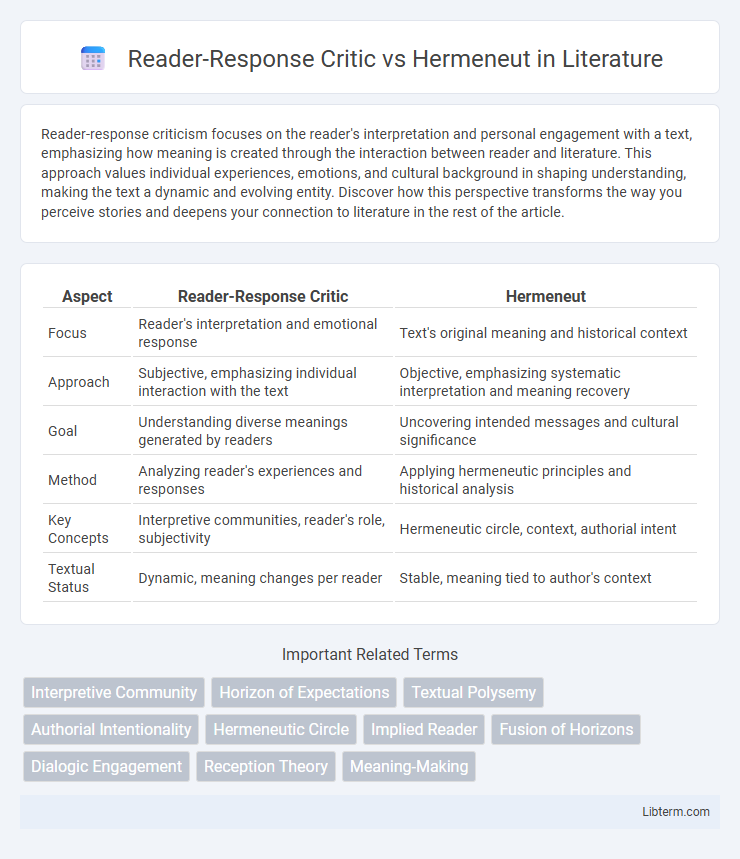Reader-response criticism focuses on the reader's interpretation and personal engagement with a text, emphasizing how meaning is created through the interaction between reader and literature. This approach values individual experiences, emotions, and cultural background in shaping understanding, making the text a dynamic and evolving entity. Discover how this perspective transforms the way you perceive stories and deepens your connection to literature in the rest of the article.
Table of Comparison
| Aspect | Reader-Response Critic | Hermeneut |
|---|---|---|
| Focus | Reader's interpretation and emotional response | Text's original meaning and historical context |
| Approach | Subjective, emphasizing individual interaction with the text | Objective, emphasizing systematic interpretation and meaning recovery |
| Goal | Understanding diverse meanings generated by readers | Uncovering intended messages and cultural significance |
| Method | Analyzing reader's experiences and responses | Applying hermeneutic principles and historical analysis |
| Key Concepts | Interpretive communities, reader's role, subjectivity | Hermeneutic circle, context, authorial intent |
| Textual Status | Dynamic, meaning changes per reader | Stable, meaning tied to author's context |
Introduction to Reader-Response Criticism and Hermeneutics
Reader-Response Criticism centers on the reader's role in interpreting a text, emphasizing personal experience and emotional engagement as crucial to meaning-making. Hermeneutics, rooted in philosophical tradition, focuses on understanding texts through historical context, authorial intent, and the dialogic process between the reader and the text. Both approaches challenge traditional objectivist views by highlighting interpretation as an interactive and evolving phenomenon within literary analysis.
Origins and Historical Development
Reader-Response Criticism emerged in the 1960s as a reaction against formalist approaches, emphasizing the reader's active role in creating textual meaning, with key figures including Stanley Fish and Wolfgang Iser. Hermeneutics, rooted in ancient philosophy and biblical interpretation, developed through scholars like Friedrich Schleiermacher and Hans-Georg Gadamer, focusing on understanding and interpreting texts within historical and cultural contexts. Both approaches transformed literary theory by shifting from author-centric to audience-centric analysis, reflecting broader intellectual movements in the humanities.
Key Philosophical Foundations
Reader-Response Criticism emphasizes the active role of the reader in creating meaning, grounded in phenomenology and existentialism, highlighting subjective interpretation as central to textual understanding. Hermeneutics, rooted in Heidegger and Gadamer, focuses on the historically and culturally situated nature of interpretation, championing the fusion of horizons between the text and interpreter. Both approaches challenge objective textual meaning but diverge on whether interpretation arises primarily from the reader's experience or the dialogical encounter with tradition and language.
Central Figures and Proponents
Reader-Response Criticism is championed by theorists like Stanley Fish and Wolfgang Iser, emphasizing the reader's role in creating meaning through interpretation. Hermeneutics, rooted in the works of Friedrich Schleiermacher and Hans-Georg Gadamer, centers on understanding texts by exploring the historical and cultural context embedded by the author. Both approaches highlight the interactive process between text and interpreter but diverge on whether meaning is constructed primarily by the reader or unveiled through interpretive traditions.
Core Principles of Reader-Response Criticism
Reader-Response Criticism centers on the reader's active role in interpreting texts, emphasizing individual experience and emotional engagement as essential to meaning creation. Unlike Hermeneutics, which seeks a definitive message grounded in authorial intent or historical context, Reader-Response prioritizes subjective interpretation and the dynamic interaction between reader and text. This approach asserts that meaning varies with each reader's perspective, making literary understanding a participatory and evolving process.
Essential Concepts in Hermeneutic Theory
Hermeneutic theory centers on the interpretation of texts by emphasizing the dynamic relationship between the reader, the author's intent, and the historical context, making understanding a circular process known as the hermeneutic circle. Reader-response criticism prioritizes the reader's subjective experience and personal interpretation, highlighting individual meaning-making over objective text analysis. Essential concepts in hermeneutics include the fusion of horizons, where the interpreter's perspective merges with the text's context, and the importance of pre-understanding that shapes comprehension.
Differences in Approach to Text Interpretation
Reader-Response Criticism emphasizes the individual reader's experience and emotional interaction with the text, asserting that meaning is co-created through personal interpretation. Hermeneutics focuses on uncovering the original intent and deeper meaning embedded by the author or the historical context, often involving systematic methodologies such as historical analysis and linguistic examination. While Reader-Response prioritizes subjective engagement, Hermeneutics seeks objective understanding through interpretative frameworks.
Role of the Reader vs. Role of Tradition
Reader-Response Criticism emphasizes the active role of the reader in creating meaning, where individual interpretation and personal experience shape the understanding of a text. Hermeneutics prioritizes the role of tradition and historical context, asserting that meaning is derived through established interpretive frameworks passed down over time. The contrast highlights a dynamic interaction between subjective reader engagement and objective cultural-historical continuity in textual interpretation.
Applications in Literary and Textual Analysis
Reader-Response Criticism emphasizes the reader's role in interpreting a text, highlighting personal engagement and the subjective experience as central to meaning-making. Hermeneutics focuses on uncovering the original intent and deeper significance through systematic interpretation, often by analyzing linguistic and historical contexts. Both approaches apply to literary and textual analysis by balancing subjective interpretation with objective understanding, allowing for diverse insights into texts from contemporary novels to ancient manuscripts.
Comparative Strengths and Limitations
Reader-Response Criticism emphasizes the reader's interpretation, allowing diverse meanings shaped by individual experiences, enhancing subjective engagement but risking inconsistent analysis. Hermeneutics centers on uncovering the author's intended meaning within historical and cultural contexts, providing structured understanding yet potentially limiting interpretive flexibility. Both approaches complement each other by balancing personal response with contextual insight, though each faces challenges in maintaining analytical rigor versus interpretive freedom.
Reader-Response Critic Infographic

 libterm.com
libterm.com